San Leonardo | |
|---|---|
| Municipality of San Leonardo | |
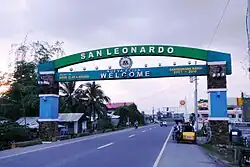 Welcome arch | |
 Seal | |
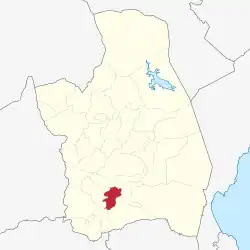 Map of Nueva Ecija with San Leonardo highlighted | |
OpenStreetMap | |
.svg.png.webp) San Leonardo Location within the Philippines | |
| Coordinates: 15°21′40″N 120°57′44″E / 15.3611°N 120.9622°E | |
| Country | Philippines |
| Region | Central Luzon |
| Province | Nueva Ecija |
| District | 4th district |
| Barangays | 15 (see Barangays) |
| Government | |
| • Type | Sangguniang Bayan |
| • Mayor | Froilan A. Nagaño |
| • Vice Mayor | Amerigus B. Nagaño |
| • Representative | Emerson D. Pascual |
| • Municipal Council | Members |
| • Electorate | 42,651 voters (2022) |
| Area | |
| • Total | 151.90 km2 (58.65 sq mi) |
| Elevation | 29 m (95 ft) |
| Highest elevation | 51 m (167 ft) |
| Lowest elevation | 18 m (59 ft) |
| Population (2020 census)[3] | |
| • Total | 68,536 |
| • Density | 450/km2 (1,200/sq mi) |
| • Households | 17,243 |
| Economy | |
| • Income class | 1st municipal income class |
| • Poverty incidence | 5.14 |
| • Revenue | ₱ 345.9 million (2020) |
| • Assets | ₱ 552.9 million (2020) |
| • Expenditure | ₱ 286.4 million (2020) |
| • Liabilities | ₱ 277.5 million (2020) |
| Service provider | |
| • Electricity | Nueva Ecija 2 Area 2 Electric Cooperative (NEECO 2 A2) |
| Time zone | UTC+8 (PST) |
| ZIP code | 3102 |
| PSGC | |
| IDD : area code | +63 (0)44 |
| Native languages | Tagalog Ilocano |
| Website | www |
San Leonardo, officially the Municipality of San Leonardo (Tagalog: Bayan ng San Leonardo), is a 1st class municipality in the province of Nueva Ecija, Philippines. According to the 2020 census, it has a population of 68,536 people.[3]
History
During World War II, Imperial Japanese forces sacked San Leonardo in 1942 during the opening stages of the Japanese Occupation. Novo Ecijano and Hukbalahap Communist guerrilla resistance groups from 1942 to 1944 in the town fought the invaders, with liberation coming in 1945 by the Allied troops.
From January to April 1945, the combined military force of the Philippine Commonwealth Army, Philippine Constabulary, and the United States Army recaptured and liberated the town. The joint forces assisted the Novo Ecijano and Hukbalahap Communist resistance groups and defeat the Japanese soldiers and officers under the Imperial Japanese Armed Forces and the Makapili soldiers and begins the Battle of San Leonardo and the Battle of Gapan between the Japanese and the combined American and Philippine Commonwealth troops on January to April 1945 and ended World War II.
Geography
The municipality has a land area of 151.90 square kilometers or 58.65 square miles which constitutes 2.67% of Nueva Ecija's total area. This represented 2.97% of the total population of Nueva Ecija province, or 0.55% of the overall population of the Central Luzon region. Based on these figures, the population density is computed at 451 inhabitants per square kilometer or 1,169 inhabitants per square mile.[5]
San Leonardo is located between Gapan and Santa Rosa along the Maharlika Highway. It is 15 kilometres (9.3 mi) from Cabanatuan, 29 kilometres (18 mi) from Palayan, and 101 kilometres (63 mi) from Manila.
Barangays
San Leonardo is politically subdivided into 15 barangays. Each barangay consists of puroks and some have sitios.
- Bonifacio (Población)
- Burgos (Población)
- Castellano
- Diversion
- Magpapalayoc
- Mallorca
- Mambangnan
- Nieves
- Rizal (Población)
- San Anton
- San Bartolomé (Población)
- San Roque
- Tabuating
- Tagumpay
- Tambo-Adorable
Climate
| Climate data for San Leonardo, Nueva Ecija | |||||||||||||
|---|---|---|---|---|---|---|---|---|---|---|---|---|---|
| Month | Jan | Feb | Mar | Apr | May | Jun | Jul | Aug | Sep | Oct | Nov | Dec | Year |
| Mean daily maximum °C (°F) | 28 (82) |
30 (86) |
31 (88) |
33 (91) |
33 (91) |
31 (88) |
30 (86) |
29 (84) |
29 (84) |
30 (86) |
30 (86) |
29 (84) |
30 (86) |
| Mean daily minimum °C (°F) | 20 (68) |
20 (68) |
20 (68) |
22 (72) |
24 (75) |
24 (75) |
24 (75) |
24 (75) |
24 (75) |
23 (73) |
22 (72) |
21 (70) |
22 (72) |
| Average precipitation mm (inches) | 4 (0.2) |
4 (0.2) |
5 (0.2) |
11 (0.4) |
66 (2.6) |
99 (3.9) |
127 (5.0) |
113 (4.4) |
99 (3.9) |
84 (3.3) |
35 (1.4) |
14 (0.6) |
661 (26.1) |
| Average rainy days | 2.2 | 1.9 | 3.2 | 5.3 | 16.1 | 20.8 | 23.5 | 22.8 | 22.2 | 16.5 | 8.9 | 3.5 | 146.9 |
| Source: Meteoblue[6] | |||||||||||||
Demographics
|
| |||||||||||||||||||||||||||||||||||||||||||||||||||
| Source: Philippine Statistics Authority[7][8][9][10] | ||||||||||||||||||||||||||||||||||||||||||||||||||||
Religion
Majority of populace is Roman Catholic. Other religious groups have churches and places of worship in the municipality.
- St. Bartholomew the Apostle Parish Church
- Pentecostal Missionary Church of Christ (4th Watch) - Brgy. Diversion
- Bethel United Methodist Church
- Magpapalayok Catholic Church
- Saint John Marie Vianney Parish
- St. Jude Thaddeus of Nueva Ecija
- Church Of Christ Locale Of Castellano
- Iglesia Ni Cristo - Lokal ng San Leonardo
- Iglesia Ni Cristo Lokal ng Nieves
- Jesus Christ to God be the Glory Church International
- Leap of Faith Christian Church
- United Pentecostal Church -San Leonardo
- Victory Churches of Asia Incorporated
Economy
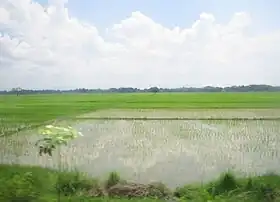
Primarily depends on rice cultivation, vegetable production, poultry, piggery & commercial fishery. The area has a farming economy. San Leonardo has vast rice fields and land for growing vegetables and poultry products.
Education
Public elementary schools
- C.I. Villaroman ES (Formerly Magpapalayok Elementary School)
- Castellano Elementary School
- Mallorca Elementary School
- Mambangnan Elementary School
- Nieves Elementary School
- San Anton Elementary School
- San Leonardo Central School
- San Roque Elementary School
- Tagumpay Elementary School
- Tambo North Elementary School
- Tambo South Elementary School
Public high schools
- Magpapalayok National High School
- Mallorca National High School
- Mambangnan National High School
- San Anton National High School
- San Leonardo National High School
- Tagumpay Nagaño High School
- Tagumpay Integrated School
Tertiary
- Nueva Ecija University of Science and Technology - San Leonardo Campus
Private schools
- Akarui Technical School Foundation
- Clever Lane Montessori School
- Dr. Gloria D. Lacson Foundation Colleges
- Lasaltech Academy
- San Leonardo Academy
- San Lorenzo Ruiz Diocesan Academy
- Seraphin Learning Center
- Trinity Christian School (TCS)
Healthcare
Hospitals and clinics can be found for their check up and treatment.
- Dr. Gloria D. Lacson General Hospital
- Nueva Ecija Medical Center
- South Ecija Doctors Hospital
Gallery
 Town hall
Town hall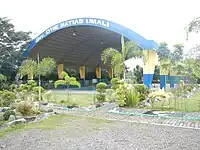 Municipal covered courts
Municipal covered courts St. Bartholomew the Apostle Church
St. Bartholomew the Apostle Church Public market
Public market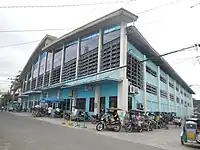 Biggest gymnasium in Nueva Ecija
Biggest gymnasium in Nueva Ecija
References
- ↑ Municipality of San Leonardo | (DILG)
- ↑ "2015 Census of Population, Report No. 3 – Population, Land Area, and Population Density" (PDF). Philippine Statistics Authority. Quezon City, Philippines. August 2016. ISSN 0117-1453. Archived (PDF) from the original on May 25, 2021. Retrieved July 16, 2021.
- 1 2 Census of Population (2020). "Region III (Central Luzon)". Total Population by Province, City, Municipality and Barangay. Philippine Statistics Authority. Retrieved 8 July 2021.
- ↑ "PSA Releases the 2018 Municipal and City Level Poverty Estimates". Philippine Statistics Authority. 15 December 2021. Retrieved 22 January 2022.
- ↑ "San Leonardo".
- ↑ "San Leonardo: Average Temperatures and Rainfall". Meteoblue. Retrieved 4 May 2020.
- ↑ Census of Population (2015). "Region III (Central Luzon)". Total Population by Province, City, Municipality and Barangay. Philippine Statistics Authority. Retrieved 20 June 2016.
- ↑ Census of Population and Housing (2010). "Region III (Central Luzon)" (PDF). Total Population by Province, City, Municipality and Barangay. National Statistics Office. Retrieved 29 June 2016.
- ↑ Censuses of Population (1903–2007). "Region III (Central Luzon)". Table 1. Population Enumerated in Various Censuses by Province/Highly Urbanized City: 1903 to 2007. National Statistics Office.
{{cite encyclopedia}}: CS1 maint: numeric names: authors list (link) - ↑ "Province of Nueva Ecija". Municipality Population Data. Local Water Utilities Administration Research Division. Retrieved 17 December 2016.
- ↑ "Poverty incidence (PI):". Philippine Statistics Authority. Retrieved December 28, 2020.
- ↑ "Estimation of Local Poverty in the Philippines" (PDF). Philippine Statistics Authority. 29 November 2005.
- ↑ "2003 City and Municipal Level Poverty Estimates" (PDF). Philippine Statistics Authority. 23 March 2009.
- ↑ "City and Municipal Level Poverty Estimates; 2006 and 2009" (PDF). Philippine Statistics Authority. 3 August 2012.
- ↑ "2012 Municipal and City Level Poverty Estimates" (PDF). Philippine Statistics Authority. 31 May 2016.
- ↑ "Municipal and City Level Small Area Poverty Estimates; 2009, 2012 and 2015". Philippine Statistics Authority. 10 July 2019.
- ↑ "PSA Releases the 2018 Municipal and City Level Poverty Estimates". Philippine Statistics Authority. 15 December 2021. Retrieved 22 January 2022.